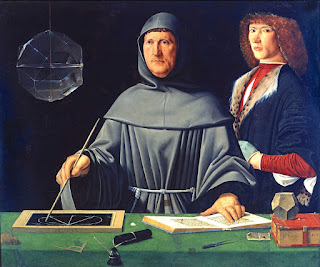De divina proportione by Luca Pacioli Plates by Leonardo da Vinci
For De divina proportione, Leonardo da Vinci created representations of 60 distinct polyhedra. These skeletal geometric figures represent the evolution of stereography, as they constitute the first clear visual distinction between the front and back perspectives of three-dimensional solids.
Up until Luca Pacioli published his book in 1509, the Platonic Solids were strictly "Solids" or wire-frame models. They were built out of glass, metal, or wood, but only as a solid. The Platonic Solids were never meant to be studied as skeletal representations of the Platonic Solids. However, Luca Pacioli donated 5 wooden Platonic Solid models to the Palazzo Magnani museum in Italy. The Milan carpenters who built the 5 Platonic Solids for Luca Pacioli must have studied stereotomy (stereotomia in Italian). They would have created a vertex drawing for each of the Platonic Solids and cut the edge pieces using the same techniques for cutting hip rafters.
Did the Milan carpenters influence Leonardo da Vinci's drawings?
In the painting of Luca Pacioli, Albert Dürer is supposedly standing to the right of Luca Pacioli. Who had drawn out the planar nets of the Platonic Solids? Dürer was also a famous artist. Born in Nuremberg, he established his reputation and influence across Europe in his twenties due to his high-quality woodcut prints. So, there is a likelihood that Albert Dürer and Leonardo da Vinci collaborated on Leonardo da Vinci's woodcut prints for Luca Pacioli's book.
In Dürer's second book, he discusses the five Platonic solids, as well as seven Archimedean semi-regular solids, and several of his own inventions. However, there is no direct evidence that Dürer knew Pacioli. Dürer's work on geometry is called the Four Books on Measurement (Underweysung der Messung mit dem Zirckel und Richtscheyt or Instructions for Measuring with Compass and Ruler).
Portrait of Luca Pacioli (1495), attributed to Jacopo de’ Barbari, Capodimonte Museum
Photo by Mostre-rò
palazzo magnani feroni, Florence, italy
With the 5 wooden Platonic Solids
On the other hand, the images of the solid bodies in solidum and vacuum display modes, shown below, were drawn by Leonardo from physical models crafted in wood or cardboard that Pacioli owned. Leonardo’s creativity and drawing mastery that vastly
surpassed Pacioli’s guidance and are vivid testimonies of how Leonardo excelled in his “ability to imagine forms in space”.

De quinque corporibus regularibus (sometimes called Libellus de quinque corporibus regularibus) is a book on the geometry of polyhedra written in the 1480s or early 1490s by Italian painter and mathematician Piero della Francesca.
Pacioli was thought to have plagiarized his best friend Francescs's work on the Icosahedron and Dodecahedron.
If n=3 the result is a polyhedron with 72 faces, that was known as Campanus' sphere and Luca Pacioli called it Septuaginta.




































No comments:
Post a Comment
Note: Only a member of this blog may post a comment.